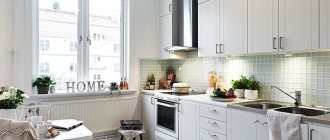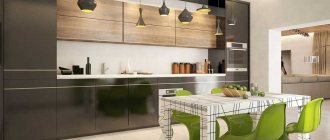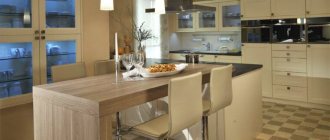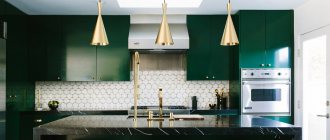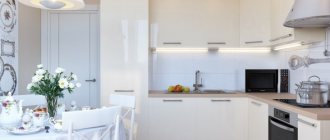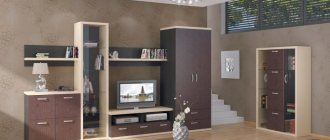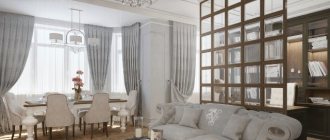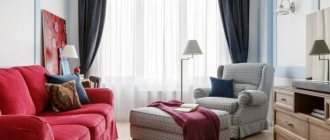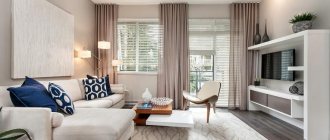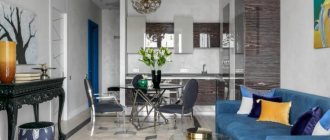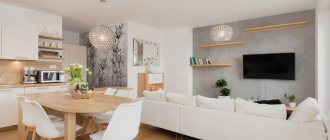The kitchen-living room is no longer a fashion trend, but a fairly common phenomenon in modern housing stock. Many developers offer ready-made solutions where there is no need to combine anything - open-plan apartments and studios. We’ll tell you about the latest kitchen-living room design ideas, and a large selection of photos of real interiors will help you find your ideal option.
Design project of a kitchen-living room: pros and cons of a combined interior
Is it always advisable to combine the kitchen and living room spaces? Each case may have its own subtleties, advantages and disadvantages.
Combining the kitchen and living room is a good idea
, If:
- the kitchen is very small, there is not enough space for cooking, storage and free movement;
- I want to get together with the whole family: while one cooks, the rest communicate;
- you need to do household chores and keep an eye on your small child at the same time: in an open space he is always in sight;
- need to save money on TV. It can be installed in such a way that it is visible from all sides.
Flaws
This solution also has:
- the need to coordinate any redevelopment and make changes to the technical passport (moving a doorway or expanding it, erecting new partitions, moving communications, etc.), which entails a loss of time, money, and often nerves;
- loss of an additional isolated room (in the case of combining the kitchen and living room in a one-room apartment). A person needs personal space and the opportunity to be alone;
- the noise and smells of the kitchen will become part of the living room. Loud refrigerator; the smell of fish that has permeated the upholstery of the sofa and curtains, or household members who wake up before you and turn on a noisy kettle at 7:00 - all this can be annoying.
The listed pros and cons are very subjective. Therefore, if such a solution will bring more benefits to you, then, of course, combine them. But remember the important nuances when redevelopment should never be done.
IT IS FORBIDDEN!
- Breaking load-bearing walls and structures.
- Combine a gasified kitchen with a living room. In this case, the problem can be solved by abandoning gas equipment and switching to an electric stove. Residents have this opportunity, but they must first apply for permission from the management company and coordinate actions with the gas service. You may be refused for completely objective and compelling reasons - unsuitable load on the electrical network.
- Independently install and change gas equipment.
- Non-residential areas cannot be located above residential areas. The kitchen is a non-residential space, and if you go to move it into the living room, then your neighbors below, having learned about it, are unlikely to be happy, since this violates sanitary standards and rules;
In this regard, residents of the first and second floors are lucky if the first floor is used for commercial purposes: the redevelopment project can be approved for them.
See also a separate selection of examples of decorating a small kitchen-living room - go to.
STYLISH STUDIO APARTMENT IN KHRUSHCHEVKA
A standard and uncomfortable “Khrushchev” can be turned into a stylish and spacious studio if you change the layout a little and choose the right design style. For this project, the corridor leading to the kitchen and at the same time being the entrance to the living room was blocked by moving the door to the corner.
On the kitchen side there was a comfortable and spacious niche in which a refrigerator could fit, and there was still room for mezzanine shelves.
Basic communications remained in place. But the new layout allowed the kitchen “wall” to continue on the adjacent wall. And in order for the refrigerator door to open freely, the set ends with a section with open semicircular shelves.
The vacated opening between the windows is reserved for the dining area. A miniature bar counter, playing the role of a dining table, fits perfectly here. The functional areas are also emphasized by the flooring: light ceramic tiles were chosen for the kitchen, and parquet of a similar light shade was chosen for the living room.
The living room, due to the displacement of the entrance door, acquired a more comfortable square shape.
Even a voluminous sofa no longer seems bulky, and the new partition will serve as an excellent location for the TV. The chosen palette also helps to visually expand the space: the interior is dominated by light shades of brown, beige and yellow.
How to combine the kitchen with the living room?
The trend towards combining kitchens with adjacent rooms is gradually losing its relevance. After all, in order to arrange both a kitchen and a living room in one room, it is not necessary to break down the partitions. Modern developers often offer ready-made spacious premises for this purpose.
If you are lucky with the kitchen area, why not arrange a relaxation area here? Even on 15 sq.m you can make a small kitchen-living room. For owners of small-sized apartments, this solution will be especially relevant, as it allows them to turn a one-room apartment into a two-room apartment.
Studio apartments are another ready-made space that initially combines several functional areas.
But for owners of apartments in old housing stock, the issue of redevelopment and its approval if they decide to combine rooms and demolish a wall will be inevitable. In Khrushchev buildings, for example, two redevelopment options are very popular:
- complete demolition of the partition between the kitchen and living room;
- moving the entrance to the kitchen from the living room and widening the opening.
Walk-through kitchen-living room in Khrushchev
Since most Khrushchev buildings are gasified, it is important to remember that redevelopment is possible if they are allowed to switch to tariffs for electric stoves and abandon gas. Another solution is to combine the rooms not really, but visually, by installing a glass partition instead of a blank wall.
MAXIMUM FUNCTIONALITY IN MINIMUM AREA
Interior feature: the kitchen and living room are walk-through, so all the furniture is located on one side of the room.
Since the size of the kitchen left much to be desired, it was decided to combine it with the living room, organizing a dining area at the junction of the rooms. The result is a spacious living room combined with a kitchen, with clearly defined zones, but leaving the impression of a single space.
An L-shape was chosen to accommodate the kitchen unit.
A tall built-in refrigerator was combined with an equally tall pencil case, which housed all the necessary household appliances. The lower cabinets are united by a single tabletop made of solid wood.
It was decided to abandon the upper cabinets so as not to clutter up the already small area. Open shelves are installed instead of cabinets: they look visually lighter, and unusual fixtures add charm to the interior.
The traditional bar counter of the most laconic form now separates the kitchen and living room and at the same time organizes the dining area. Moreover, a spacious bar was built into the lower part of the counter.
The counter is wide enough that it can easily replace a traditional dining table. It is made from the same solid wood as the tabletop. The “wooden” theme is also supported by an unusual panel near the counter.
Visual zoning is also complemented by the floor covering. Black glossy tiles along the work area in the kitchen look contrasting against the background of the rest of the laminate floor.
The structure of the laminate resembles bleached wood. This coating goes well with a kitchen apron, which is lined with brickwork.
Style
Today there is no strict framework for following a certain direction. Eclecticism and individualism are encouraged. But mixing different styles so that it looks harmonious, with rare exceptions, only a professional designer can do. If you do not want to take risks, then try to adhere to the chosen concept and the simple rules listed below:
- follow the chosen style throughout the room - both in the kitchen area and in the living room area;
- stick to a single color scheme, placing color accents in the right places.
Let's look at the most current and popular destinations.
Modern
The modern design of the kitchen-living room gravitates towards simplicity, clear and geometric lines, and laconic forms. Basic shades are always relevant - gray, white, black, beige, which in varying degrees of saturation can make up monochrome interiors.
A modern kitchen-living room is a room where there is nothing superfluous: a minimum of decor, a maximum of light and free space. Therefore, for a small room this is the most suitable design option.
Classic and neoclassical
For a kitchen-living room in a classic style, arches, two-level ceilings with antique patterns or stucco, and massive furniture with patina will be relevant. The kitchen area can be separated from the living room by a symmetrically located dining area or island.
This design is appropriate in spacious rooms, but for a small kitchen-living room it is better to choose an alternative in the form of neoclassics. Adding modern elements will make the interior lighter and freer.
Provence
The French country theme will be appreciated by lovers of romantic interiors and outdoor recreation. Therefore, this style is especially relevant for decorating country houses and dachas.
For the best ideas for decorating the interior of a kitchen-living room in the Provence style, see a separate article - go.
Scandinavian
To make the kitchen-living room in the Scandinavian style cozy, do not be afraid to add color accents characteristic of this style - red, yellow, blue, light blue, green. Wooden surfaces in the design of flooring, countertops, and dining tables will add warmth and neutralize the cold asceticism of Scandi.
Loft
The loft style for the kitchen-living room is one of the most suitable, as it originally originated in free, spacious industrial premises. Here it is better to abandon partitions, and use techniques with furniture arrangement and lighting as zoning.
For information on how to create an ideal loft-style interior, see a separate article - go to.
Minimalism
The ideal option for a small kitchen-living room is minimalism, which assumes the most simple and clear forms, minimal or complete absence of decor, smooth surfaces, an abundance of light and free space.
SYMPHONY OF COLOR
The features of the minimalist style can be described in literally three words: practicality, open space and maximum functionality. And this does not mean that minimalism is only appropriate for apartments or apartments with a large area.
Here is a striking example of a minimalist interior that has transformed a standard one-room apartment into an elegant studio apartment.
Firstly, it was decided to abandon all kinds of partitions. The kitchen, dining room and living room are now combined into a single space.
The main colors chosen are typical colors for minimalism: white, cream, sand and brown. This pastel palette is successfully diluted with a soft shade of purple.
The color purple is present on the façade of the kitchen furniture; the same color is used on the part of the wall behind the sofa and near the bar counter. The curtains decorating the living room are also matched. It is these splashes of purple that connect the entire interior into a harmonious whole.
As many people know, minimalism is characterized by clear zoning. This principle is fully embodied here. The kitchen is separated from the dining room by a high bar counter in rich black color.
Behind the bar counter there is a cozy island with a mini-dining room, where a stylish table with a glossy tabletop and soft chairs fit. Next is a living room with a cozy sofa and cabinet furniture that replaces the set.
The flooring also differs: on the kitchen side the floor is covered with ceramic tiles, in the room there is laminate. But the materials are different only in structure, but they are as close as possible in color. The lighting deserves special mention.
Built-in lighting located along the ceiling visually highlights the kitchen. Low pendant lamps accentuate the bar counter. There was a place for a cozy sconce in the dining area. And for the living room, the designers have provided a stylish ceiling chandelier.
Color design
Color sets the mood of the interior, and its choice is tied to the chosen stylistic direction.
Bright hues
Light colors are suitable for a small kitchen-living room or for interiors in a certain style.
The classic interior is characterized by a beige color scheme, the Scandinavian interior is predominantly white with bright color accents, and Provence is characterized by a delicate, pastel range of lilac, blue, pink, and cream shades.
Dark colors
Snow-white interiors have been replaced by the fashion for dark kitchens. Today, deep and complex gray-green, dark green, blue, earthy, rusty shades are relevant.
An obstacle to using dark shades in the interior of the kitchen-living room is the small area. In conditions of 15-20 square meters, they can visually narrow the room, but this only applies to cases when there is a choice of a dominant color scheme. After all, dark shades can only be used locally - for example, make only one accent wall black or dark blue.
Dark colors will make the interior of the kitchen-living room more austere and status. To emphasize this effect, it is important to use natural textures in the design - wood, concrete, stone. Light furniture, bright accessories and decorative items will stand out against the background of dark shades. Textiles made from dense and rich fabrics such as velvet, corduroy, velor will look beautiful, which can be used in the design of curtains or upholstered furniture in the living room area - sofa, armchairs.
Some styles are very fond of dark shades - art deco, fusion, loft, English classics.
Bright design
The most radical solution is to make the entire kitchen-living room bright; it may only be advisable if the living room is not a living room, and in addition to it there is another place in the apartment where you can relax. Bright colors invigorate and charge with energy, but the downside of a rich interior is irritation and rapid fatigue. Therefore, it is always better to dilute them with neutral tones - basic gray, white, beige.
You can add a color accent to:
- kitchen set;
- apron,
- one wall;
- on upholstered furniture, buying a bright yellow sofa or armchairs in rich rich colors;
- cabinet furniture (bright shelving or cabinet);
- accessories (carpet by the sofa, vase, paintings, etc.).
Less familiar and original solutions are a colored door, window frame or ceiling.
FASHIONABLE INTERIOR IN NEOCLASSICAL STYLE
The original studio apartment was made from an ordinary one-room apartment with a standard layout. After the redevelopment, it was possible to place a separate bedroom here, allocate an area for the living room and office, and equip a very spacious kitchen and bathroom.
The L-shaped kitchen set fits well into the interior without taking up much space. We managed to save on built-in appliances and the location of the oven and microwave in one column. The upper cabinets are not wide and low. The upper part of the walls remains free, which visually makes the ceilings higher and the room more spacious.
The kitchen area is additionally highlighted by a plasterboard ceiling box with built-in lighting. This box continues along the entire perimeter of the room, further connecting the space into a single whole.
Next to the kitchen there is a dining area. A small table and a few soft chairs create a cozy atmosphere. A low ceiling chandelier adds grace to this area. The living room was visually divided into two more zones.
A soft corner sofa limits the seating area, and next to it, behind the bar counter, there is a mini-office. The bar counter in this case ideally plays the role of a desk.
Lamps (a separate ceiling chandelier above each zone) and flooring also act as zone delimiters: ceramic tiles in the dining room and kitchen, laminate flooring in the living room. The style chosen for the room is neoclassical with elements of minimalism.
Thus, the neoclassical style made it possible to introduce variety: one wall was covered with wallpaper with a dim pattern, and stylish decor appeared in the form of original figurines and vases. Minimalism dictated the choice of colors and the laconicism of furniture shapes.
The above photo examples of interiors show that a kitchen combined with a living room allows you not only to gain space, but also to create an interesting and stylish design.
Kitchen-living room layout options
A well-chosen layout is half the success in the design of a kitchen-living room.
When planning, it is important to consider the following.
- Features, size and shape of the room.
When arranging furniture and designing, first of all, the real opportunity to choose one or another layout is taken into account. For example, the width of the kitchen may not be enough for a U-shaped set, or the location of windows and doors may interfere with the installation of a corner kitchen. It is necessary to start from the location of the riser and water supply: although moving the sink is possible, it is problematic and limited by certain legal frameworks.
- Personal needs.
Do you really need a spacious, large kitchen? After all, by increasing the number of storage spaces, you sacrifice free space. And for a small kitchen-living room it is more valuable. Adequately assess how many cabinets and drawers you need to hide the necessary kitchen utensils and utensils. You can do this using the example of the kitchen you are currently using.
Don’t be afraid of non-standard and unusual solutions - kitchens without upper cabinets, double-row, asymmetrical layouts, etc. In rooms with architectural features and poor placement of windows and doors, such ideas may be the best option.
Rectangular
For a rectangular kitchen-living room, the most suitable option is a linear or straight layout - when the kitchen cabinets are located in one row.
If you do not need a large and roomy kitchen set, then it is more advisable to install furniture along a short wall: this way you will mitigate the disadvantages of the layout.
Square
Depending on the location of windows and doors, in a square room there are two possible configuration options for a kitchen set - corner or straight. The first will allow you to increase the working surface, the second will look lighter and more compact in the interior.
With bay window
A bay window is an ideal place for a dining area.
If there are other options for a good location for the dining area, then you can install a kitchen set in the bay window. But this idea is advisable only on the condition that the communication lines are located nearby, and they do not have to be pulled across the entire room. In any case, you need to make a set for a bay window to order, which will add 20-30% to the cost of the furniture.
SIMPLE AND LIGHT DESIGN
The minimalist style is ideal for decorating studio apartments.
Firstly, it allows you to emphasize the freedom and airiness of the space, and secondly, it helps to remain within the bounds of practicality and ergonomics, and to avoid unnecessary decor and clutter.
Here is the design of a studio apartment, where we managed to place a kitchen, dining room and living room in a small area. Thanks to the successful layout and competent zoning, each zone seems as isolated as possible.
The kitchen is equipped with furniture and built-in appliances. Laconic-shaped facades are made of MDF. The white glossy fronts of the upper cabinets merge with the white wall, and the cabinets seem light and weightless.
The lower facades are finished “like wood” and repeat the pattern of the floor covering. The corner of the kitchen is slanted, which made it possible to place a sink here, thereby gaining additional surface for the worktop.
The kitchen is separated from the dining room by a narrow bar counter of the simplest form. This stand does not look massive, and stylish lamps make it even more airy. The dining room was in the corner. It is united with the kitchen by the white color of the furniture, and with the living room by curtains of a rich chocolate shade.
The same color was chosen for the sofa cushions in the living room. A round chandelier above the dining table further emphasizes the isolation of the dining room.
A large corner sofa highlights the living area. There is also room for a coffee table and a TV stand.
The entire interior can be called a kingdom of straight lines. Everything is subject to strict geometry: from the layout to the shapes of furniture and lamps. Soft folds of curtains, carved backs of bar stools and an abundance of indoor plants add sophistication.
Materials and finishing
Finishing materials can act as a tool for zoning the kitchen-living room space, but their design should not argue with each other, since, ultimately, it is important to obtain a stylistically unified space.
Floor
As we said above, combining different materials for floor finishing is a bad idea. In addition to difficulties with selecting a design, there may be problems with their joining. In most cases, aesthetics will suffer. Therefore, it is easier to choose a solid covering for the entire kitchen-living room.
Considering the high traffic and wet areas in the kitchen, the search for materials should be narrowed to waterproof, practical and wear-resistant options:
- porcelain stoneware;
- quartz vinyl tiles or PVC floor tiles;
- linoleum 32, 33 classes.
STYLISH INTERIOR IN WARM COLORS
The peculiarity of this apartment was that the wall in the kitchen, along which communications were laid, was common with the room.
Therefore, the kitchen perfectly accommodated the bedroom, and to organize the kitchen space combined with the living room, there was no need to move communications.
The entire kitchen is ideally located along this wall. There is now a standard kitchen unit with built-in appliances here.
Additionally, the kitchen area is highlighted with a plasterboard structure: it hid the side parts of the kitchen furniture, and the entire set seemed to be built into the wall.
White glossy facades, reflecting sunlight, add weightlessness and lightness to this island. The highlight of the kitchen is the apron, made of matte tiles with a dim pattern.
The free space near the “kitchen wall” was taken by the dining room. A round table and an equally round lamp break up the linearity of the interior and make the dining area especially cozy and private.
The living room is separated from the dining room and kitchen by a passage
A small cozy sofa and a laconic coffee table fit here. And the role of a TV stand is played by a small hanging shelf. Thanks to the white color of the surfaces, the shelf merges with the wall and seems weightless.
For the floor in the kitchen-living room, the designers chose oak boards coated with oil. This coating is not afraid of contamination, since even the most insidious stains can be easily removed by simply sanding the boards.
Lighting and backlighting
Lighting plays a special role in the design of the kitchen-living room.
- Decorative.
The lamp itself can become a decoration and even the main accent in the interior, and decorative lighting of display cabinets will create a completely magical atmosphere in the evening.
- Zoning.
Pendant lights can visually separate the dining area, and the ability to dim the lighting in different parts of the room will illuminate a specific area of the room. Relaxing in the living room and want to hide the kitchen from view? It is enough to dim or completely turn off the lights in this area.
- Functional.
The direct task in organizing lighting is to make the process of being in the room as comfortable as possible. Therefore, it is necessary to provide separate lighting sources in each zone:
- general diffused lighting;
- directional lighting in the form of LED lighting in the kitchen work area;
- directional lighting above the dining area;
- soft and diffused light in the recreation area (from floor lamps, sconces, etc.).
If desired, you can equip lighting inside kitchen cabinets, illuminate display cabinets and sideboards. It is not only convenient, but also beautiful.
BLACK AND WHITE CONTRAST
Since the apartment area is small, it was decided to combine the kitchen, living room and loggia, creating a single space. The loggia houses a comfortable office, and the living room and kitchen, due to the same style, appear as a single whole.
The design style chosen is modern: minimalism with art deco elements. The choice of style was also dictated by the color scheme - a harmonious combination of white, black, sand and gray.
A distinctive feature of this interior is its clear zoning.
The kitchen and loggia are separated by a stylish bar counter, the shape of which follows the outline of the kitchen unit. Visual zoning is also supported by the floor covering: in the kitchen there are white ceramic tiles, in the recreation area there is parquet.
Manufactured furniture was chosen for the kitchen. Laconic white facades contrast perfectly with the black surface of the work area and bar counter. The set is complemented by high bar stools.
The highlight of the kitchen interior is the apron. It is made of glass with a mirror coating and a geometric pattern. The same mirror inserts decorate the upper hanging cabinets.
Please note that the upper cabinets in the kitchen are low. Shelves are hung at the same level in the living room. This horizontal line, like a ring, unites the space. The result is a harmonious interior of a spacious room in a modern style.
Real photos of kitchen-living room interiors
You can find more ideas for inspiration in the large selection of design examples in the photo below.
Kitchen combined with a living room in a Khrushchev building
In a private house
In the country
Kitchen-living room in country style with a real fireplace
With bedroom
Combined kitchen-living room in Stalin
Studio
Small kitchen-living room
MODERN MOTIF IN LOFT STYLE
The loft style has recently entered the world of design. It combines such characteristic features as high light ceilings, a combination of classic and modern, practicality and a restrained color palette.
We also recommend watching an excellent video on the topic of combining a kitchen and living room.
As you can see in the photo, this is the style that was chosen for the design of the kitchen combined with the living room, located in a new building apartment.
In the fairly spacious kitchen, it was decided to highlight the dining area, making it as isolated as possible.
The entire kitchen set is located along the walls in the shape of the letter “L”. The facades of the lower cabinets and high pencil case are made of MDF in a delicate sand shade.
On the pages of our website you will learn how to choose the right curtains for the bedroom.
The fronts of the upper cabinets are black, glossy. Their shine visually “pushes” the walls, while simultaneously delineating the kitchen area from the dining room.
Zoning is also supported by a two-tier plasterboard ceiling. In the kitchen area, the ceiling is lowered, which made it possible to install built-in ceiling lights. The cornice in the dining room is also located at the same level.
If the ceiling separates, then the floor visually unifies the interior: it is all laid out with a laminate that imitates a wooden covering. The dining area has a comfortable sofa, a low table and a couple of soft chairs. The color of the furniture matches perfectly with the color of the kitchen unit.
The restrained palette of the interior is enlivened by modern curtains - long, with soft folds, made of fabric of a delicate turquoise shade.
The sofa cushions are also made from textiles of the same color. Retro lamps and panels of paintings complement the decor of the dining room.
Options for placing a kitchen and dining area in the living room
A kitchen area that occupies one of the walls of the room is a frequent design technique for combining several zones in one space. In this case, the kitchen set is arranged in one row or in an L-shape. Most often, such kitchen ensembles are accompanied by the installation of an island or peninsula.
Another popular option for locating the kitchen area is in the corner of the room. Obviously, with this arrangement, the most rational is to use a corner or L-shaped kitchen layout. As you know, the corner layout is the most versatile option and is suitable for both spacious rooms and rooms with modest sizes; if you complement this layout with a kitchen island, you can place a large number of storage systems, work surfaces and household appliances on several square meters. In this case, the kitchen island can act as a breakfast bar or dining area if the household does not have a dining room or if there are 2-3 people living in it.
If your living room has a staircase leading to the second floor, then the space near it is more convenient and rational to use for arranging a kitchen segment. The optimal location for the kitchen would be near the stairs if there is a window on the opposite wall. There is never too much natural light, especially in the work area of the kitchen space.
If your room, in which several functional areas will be located, is quite long, then placing the kitchen space in the center of one of the largest sides will be an ideal option. With this arrangement, it is convenient for a housewife busy in the kitchen to communicate with household members nearby in the living area. During receptions and parties, it is very convenient to prepare snacks and move them to the dining or living area, while remaining in the social circle without feeling disconnected. From the point of view of arranging a family dinner or lunch, the kitchen area is located close to the dining room and you don’t have to “walk miles” with dishes and ready-made dishes.
The parallel layout of a kitchen ensemble for studio rooms or living rooms with a kitchen is used extremely rarely. But if your large room has a complex shape and there is a nook of several square meters in the passage space, then such a place would be optimally equipped with a kitchen set located in two rows.
For small rooms in which the kitchen is combined with the living room, you can consider installing the kitchen unit in one row with a short length. If 2-3 people live in the house and there are no small children or elderly people among them, then to organize the dining area you can limit yourself to a small console or a prefabricated table, which, if necessary, can be folded against the wall to save space.
The advantage of combining the kitchen and living areas into one large room is that you can place the dining group within the kitchen segment. At the same time, the number of work surfaces, storage systems and household appliances does not need to be reduced. Serving food to the table and collecting dirty dishes at the end of the meal is greatly simplified - all functional segments are located close to each other. In addition, this arrangement of the dining table is closer to our compatriots due to the mentality; not in many Russian kitchens can you yet find kitchen islands used as places for meals.
“Kitchen in a closet” is an original way to disguise the kitchen area in the living room. The built-in small kitchen unit is located in a niche that can be closed with folding doors. Such designs are very convenient to hide during receptions and parties. The rest of the time, the doors of the makeshift cabinet can be open - its insides contain all the necessary elements for carrying out working kitchen processes.
If your hob or stove is integrated into the kitchen island, then you will have to place the hood above it, attaching the structure to the ceiling. The importance of purchasing a powerful and, if possible, silent hood cannot be overestimated in combined spaces. After all, while you are frying fish in the kitchen area, your household members are relaxing in the soft section of the living room or watching TV, and smells and sounds can disturb them, and you don’t want the upholstery of upholstered furniture to be saturated with the aromas of the kitchen.
Do you have a small bathroom? Read about fashionable design for a small bathroom here
Wealth of choice of stylistic solutions
For a harmonious environment in a large kitchen-dining-living room, it is better to adhere to one stylistic solution in all functional segments or choose stylistics that are similar in concept and do not contradict each other. The easiest way is to take one interior design style as a basis and, if desired, add furniture or decorative elements from other stylistic solutions, but do this either dosed as accents, or throughout, but without highlighting the features with bright colors, textures or methods of execution.
Classic cuisine is always in trend. And the most popular version of its execution is snow-white (sometimes in combination with pastel or neutral shades in furniture or decoration). With such a kitchen it will be easy to combine the decoration and furnishings of the living room - natural shades, the use of natural materials for the manufacture of furniture and decorative items, glass lighting fixtures (possibly with decorative elements), upholstered furniture with neutral upholstery and natural textiles for window decoration.
Modern interior design style strives for minimalist motifs, enclosed in an attractive outer shell with a mandatory practical load. Simple and clear forms, smooth surfaces, neutral colors, only the necessary furniture and a minimum of decor - everything strives to ensure that the room is comfortable, but convenient from the point of view of use and cleaning. In such an environment, it is easy to relax, clear your thoughts and emotions, and tune in to peace and tranquility.
Just a few pieces of furniture or decor in a rustic style are enough for a completely traditional setting to acquire a touch of country style - the use of some rusticity in the manufacture of a dining table or small stands, carpets imitating animal skins, lighting fixtures with forged parts of simple shapes.
Kitchen shape: choosing a design
The kitchen of a private house is, for the most part, guaranteed spaciousness. To create a functional and comfortable interior, you should take into account the shape of the room.
Bright decor will enliven even the darkest room
The room can be of a familiar shape or have a non-standard layout.
Square is the best option
This form is one of the simplest and most convenient to design. Functionality and comfort with the correct shape of the room and a large area are not difficult to implement.
Functionality and comfort
The square shape allows you to position the furniture set even on three sides. In this case, the dining area can occupy the center of the room.
If it is more convenient to move it to a free wall, then you can use, for example, photo wallpaper, wood stylization, or use a contrasting background to decorate a vertical surface.
We place the furniture set on three sides
If the square kitchen in a private house is small, then it is better to place the work area furniture along one wall. In this case, you will have to take into account the location of the window.
When decorating walls with wallpaper, you can give freedom to your imagination - in a room of this shape, almost any wallpaper will look beautiful.
Don't be afraid to give free rein to your imagination
Dining furniture for this kitchen should preferably have a large comfortable table and equally comfortable chairs.
Narrow and long room: overcoming planning difficulties
A private house can be designed not only with a square kitchen, but also with a narrow one. This problem will have to be overcome with the help of a selected design. An important task is to visually expand the space.
A large dining table is very practical in the interior
For this, it is good to use light shades in the interior. Which style do you prefer? Provence is one of the best options if this style blends organically with the interior of the rest of the premises.
Provence is natural, gravitates towards light shades and gives the room a lightness that is so lacking in a long narrow space.
The light range of shades adds lightness
What else should I do? One of the requirements is not to clutter or weigh down the space.
Appliances and furniture should only be necessary. If there are lockers that are not particularly needed, we eliminate them.
It is very important not to clutter even a large room
Do you like to arrange souvenirs on shelves and hang pictures on the walls? They will also have to be abandoned.
We decorate the windows with attractive and always light curtains. Unfortunately, the dining area does not fit into the too narrow space of the kitchen.
Window decoration with light curtains
Non-standard layout: shape dictates design
Unusual layouts require individual design. The design of such a kitchen must take into account the curves of the walls, the number and size of windows.
Each kitchen is individual, just like its owners
The set for a non-standard room design is selected according to specific parameters.
Methods for zoning space
Among the obvious ways of zoning certain functional segments of a room are arches, various beams, columns and supports, which do not hide the zone from view, but give a clear idea of its boundaries. In modern premises, the kitchen area is most often subject to such zoning.
With the help of screens, which are most often storage systems, you can not only successfully set boundaries between zones, but also equip the room with spacious hinged or pull-out cabinets.
The next popular way to mark the invisible boundaries of the kitchen space from the living room is to highlight the level using a suspended ceiling. Typically, a lower ceiling level is constructed above the kitchen segment, into which a lighting system is built. Obviously, the lighting of the kitchen area should be brighter than the relaxation segment - the living room. In addition to the functional load, such structures can also play a decorative role if original shapes or unusual colors or photo printing are added to the design of the multi-level ceiling.
One of the obvious and most practical ways of zoning space is to use different floor coverings in different functional segments. To simplify cleaning processes, the flooring of the kitchen area is made of easily washable materials with high resistance to moisture - porcelain stoneware, stone tiles or linoleum. In turn, the living room area can be decorated in any type of flooring - from wooden parquet to carpet. In modern design projects for kitchens and living rooms, you can increasingly see zoning using carpeting, which is located in the recreation segment.
An excellent way to zone space is a bar counter, which can serve as a place for breakfasts and other short meals in the kitchen area and as a support for a sofa, for example, in the living room segment. This rational arrangement of furniture significantly saves usable space in a small living room.
And the last, but not least popular method of zoning the kitchen space located in the living room is the use of different wall finishes. Obviously, vertical planes in the kitchen segment will be subject to greater exposure to moisture, temperature changes, mechanical abrasion and contamination.
And, nevertheless, in modern living rooms we increasingly see a uniform finish throughout the entire room; only the kitchen apron is given an individual choice of finishing materials. This is primarily due to the fact that most homeowners want to get a harmonious environment in a large and functional room, without clearly defined boundaries and differences in the methods of finishing different zones. An alternative to such zoning can be the choice of finishing materials of the same palette, but different in their technological qualities. For example, wallpaper and ceramic tiles or plastic wall panels of the same shade will look more than appropriate in different functional segments located within the same room.
